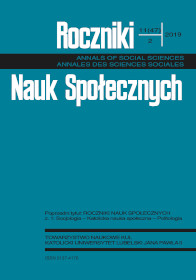Middle-Class Formative Factors in the Moldovan Contemporary Society
Abstract
The sociological research on the formation of middle class in the Republic of Moldova, conducted from June to September 2016 by the researchers from the Sociology and Social Psychology Centre, shows that the Moldovan society is stratified into 6 levels that is diversified by the socio-professional status, education and the level of wellbeing. Status inconsistency and the low level of status crystallisation are characteristics for all the strata within the conditions of dysfunctionality of the logical chain: education — social and occupational status — welfare. The analysis of social strata in terms of middle class criteria (high socio-occupational status, high education level, high level of welfare) shows some prospects for the formation of middle class in the upper strata under the following conditions: development a salary policy, reforming tax policies by promoting the progressive taxation, elimination of corruption in structures of power, improving legislation, assuring proper conditions to enable the population to access educational and health services.
References
Barber, Bernard. Social Stratification. A Comparative Analysis of Structure and Process. New York: Harcourt, 2011.
Bendix, Reinhard, and Seymour M. Lipset, eds. Class, Status, and Power. New York: Free Press, 1966.
Clark, Terry N., and Seymour M. Lipset. “Are Social Classes Dying?” International Sociology 6, no. 4 (1991): 397–410.
Dogan, Mattei. Status Incongruence in Advanced Societies. SocietàMutamentoPolitica 2, no. 3 (2011): 285–94. https://doi.org/10.13128/SMP-10332.
Domański, Henryk, Zbigniew Sawiński, and Kazimierz Słomczyński. Sociological Tools Measuring Occupations. New Classification and Scales. Warsaw: Ifis Publishers, 2009.
Fulton, Diane, David Furman, and Nikki Finlay. “A Longitudinal Study of the Middle Class: Growth, Size and Marketing Strategies.” Research in Business and Economics Journal 10 (October 2014). https://www.aabri.com/manuscripts/142031.pdf.
Giddens, Anthony. Социология. Москва: УРСС, 2005.
European Social Survey. How to Ascertain the Socio-Structural Position of the Individual in Society. European Social Survey Core Questionnaire. Accessed November 25, 2018. https://www.europeansocialsurvey.org/docs/methodology/core_ess_questionnaire/ESS_core_questionnaire_measuring_social_structure.pdf.
Razumkov Centre. Middle class in Ukraine: Identification Criteria. Expert Assessments, Citizens’ Perceptions and Self-Identification. Kyiv: Zapovit, 2014. Accessed November 25, 2018. http://fnst.org/sites/default/files/uploads/2016/08/02/1416488152file1.pdf.
Parsons, Talcott. Essays in Sociological Theory: Pure and Applied, 166. Glencoe, IL: Free Press, 1949.
Pressman, Steven. “Defining and Measuring the Middle Class.” Working Paper 7. American Institute for Economic Research, August 2015. Accessed November 26, 2018. https://www.aier.org/wp-content/uploads/2016/10/WP007-Middle-Class.pdf.
Raduleț, Ani. “Stratificarea sociala.” Revista Transilvană de Ştiinţe Ale Comunicari 14, no. 3 (2011): 93–104.
Shah, Shelly. “Social Stratification: Meaning, Origin, Development and other Details.” Sociology Discussion. Accessed November 26, 2016. http://www.sociologydiscussion.com/social-stratification/social-stratification-meaning-origin-development-and-other-details/2260.
Shortell, Timothy. “Weber's Theory of Social Class.” Brooklynsoc. Accessed November 25, 2019. http://www.brooklynsoc.org/courses/43.1/weber.html.
Sorokin, Pitirim. Social and Cultural Mobility. Glencoe, IL: Free Press, 1959.
Tarkhnishvili, Anna, and Levan Tarkhnishvili. “Middle Class: Definition, Role and Development.” Global Journal of Human Social Science Sociology & Culture 13, no. 7 (2013): 21–31.
Авраамова, Елена. “Формирование среднего класса в России: определение, методология, количественные оценки.” Общественные Науки и Современность [Avraamova,Yelena. “Formirovaniye srednego klassa v Rossii: opredeleniye, metodologiya, kolichestvennyye otsenki.” Obshchestvennyye Nauki i Sovremennost'], no. 1 (2002). Accessed November 25, 2016. http://ecsocman.hse.ru/data/799/893/1231/2.pdf.
Бакштановский, Владимир, and Юрий Согомонов. Этос среднего класса: Нормативная модель и отечественные реалии. Тюмень: Центр прикладной этики, 2000. [Bakshtanovskiy, Vladimir, and Yuriy Sogomonov. Etos srednego klassa: Normativnaya model’ iotechestvennyye realii. Tyumen': Tsentr prikladnoy etiki, 2000.] Accessed November 25, 2016. http://www.tyuiu.ru/wp-content/uploads/2015/10/Bakshtanovskij-V.I.-Sogomonov-YU.V.-Etos-srednego-klassa.pdf.
Соболев, Алексей. “Дифференциация подходов к исследованию среднего класса в стратификационной модели современного российского общества. Aвтореферат на соискание степени кандидата социологических наук.” [Sobolev, Aleksey. “Differentsiatsiya podkhodov k issledovaniyu srednego klassa v stratifikatsionnoy modeli sovremennogo rossiyskogo obshchestva. Avtoreferat na soiskaniye stepeni kandidata sotsiologicheskikh nauk.”] Phd diss., Russian Academy of Sciences, 2013. Accessed November 26, 2016. http://www.dissercat.com/content/differentsiatsiya-podkhodov-k-issledovaniyu-srednego-klassa-v-stratifikatsionnoi-modeli-sovr.
Copyright (c) 2019 Roczniki Nauk Społecznych

This work is licensed under a Creative Commons Attribution-NonCommercial-NoDerivatives 4.0 International License.


